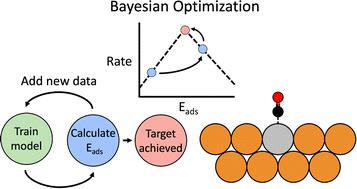当前位置:
X-MOL 学术
›
J. Mater. Chem. A
›
论文详情
Our official English website, www.x-mol.net, welcomes your
feedback! (Note: you will need to create a separate account there.)
Bayesian optimization of single-atom alloys and other bimetallics: efficient screening for alkane transformations, CO2 reduction, and hydrogen evolution
Journal of Materials Chemistry A ( IF 10.7 ) Pub Date : 2023-08-29 , DOI: 10.1039/d3ta02830e Gbolade O. Kayode 1 , Avery F. Hill 1 , Matthew M. Montemore 1
Journal of Materials Chemistry A ( IF 10.7 ) Pub Date : 2023-08-29 , DOI: 10.1039/d3ta02830e Gbolade O. Kayode 1 , Avery F. Hill 1 , Matthew M. Montemore 1
Affiliation

|
Single-atom alloys form an important class of material that has shown great potential in maximizing the use of rare and expensive metals in catalysis due to their high catalytic performance, robustness, tunability and unique structure. Single-atom alloys present particular challenges for screening as they can deviate from some traditional catalyst design frameworks. While machine learning (ML) can be quite useful in accelerating catalyst design, most traditional ML methods require relatively large datasets and/or high-level, expensive featurization. Additionally, most of these ML methods are incapable of handling multiple objectives and constraints over the intended search space. In this work, we leverage Bayesian optimization (BO) to guide our search for high-performing catalysts. We show that our BO workflow can be initialized with as few as 2 to 8 data points, and often identifies the optimal single-atom alloy surface in just a few iterations. Our workflow was used to efficiently search across multiple adsorption systems and datasets and significantly outperformed a random search method, using simple, off-the-shelf features. For applications, we used BO to identify potential high-performing catalysts for alkane transformations, CO2 reduction, and hydrogen evolution. Our BO workflow identified Hf1Cu for alkane transformations; Y1Au, Y1Cu and Y1Ag for CO2 reduction; and an Ag–Ir bimetallic alloy for hydrogen evolution. Simple stability tests indicate all three single-atom alloys for CO2 reduction are stable and most likely synthesizable. The workflow developed here can also be used for experiments or high-level theory calculations as well as other classes of materials.
中文翻译:

单原子合金和其他双金属的贝叶斯优化:有效筛选烷烃转化、二氧化碳还原和析氢
单原子合金是一类重要的材料,由于其高催化性能、鲁棒性、可调性和独特的结构,在最大限度地利用稀有和昂贵的金属在催化方面显示出巨大的潜力。单原子合金对筛选提出了特殊的挑战,因为它们可能偏离一些传统的催化剂设计框架。虽然机器学习 (ML) 在加速催化剂设计方面非常有用,但大多数传统的 ML 方法需要相对较大的数据集和/或高级且昂贵的特征化。此外,大多数机器学习方法无法处理预期搜索空间上的多个目标和约束。在这项工作中,我们利用贝叶斯优化(BO)来指导我们寻找高性能催化剂。我们表明,我们的 BO 工作流程可以用少至 2 到 8 个数据点进行初始化,并且通常只需几次迭代即可识别最佳的单原子合金表面。我们的工作流程用于跨多个吸附系统和数据集进行有效搜索,并且使用简单的现成功能,显着优于随机搜索方法。对于应用,我们使用 BO 来识别用于烷烃转化、CO 的潜在高性能催化剂2还原、析氢。我们的 BO 工作流程确定了用于烷烃转化的Hf 1 Cu;用于CO 2还原的Y 1 Au、Y 1 Cu和Y 1 Ag;以及用于析氢的Ag-Ir双金属合金。简单的稳定性测试表明用于CO 2还原的所有三种单原子合金都是稳定的并且很可能是可合成的。此处开发的工作流程还可用于实验或高级理论计算以及其他类别的材料。
更新日期:2023-08-29
中文翻译:

单原子合金和其他双金属的贝叶斯优化:有效筛选烷烃转化、二氧化碳还原和析氢
单原子合金是一类重要的材料,由于其高催化性能、鲁棒性、可调性和独特的结构,在最大限度地利用稀有和昂贵的金属在催化方面显示出巨大的潜力。单原子合金对筛选提出了特殊的挑战,因为它们可能偏离一些传统的催化剂设计框架。虽然机器学习 (ML) 在加速催化剂设计方面非常有用,但大多数传统的 ML 方法需要相对较大的数据集和/或高级且昂贵的特征化。此外,大多数机器学习方法无法处理预期搜索空间上的多个目标和约束。在这项工作中,我们利用贝叶斯优化(BO)来指导我们寻找高性能催化剂。我们表明,我们的 BO 工作流程可以用少至 2 到 8 个数据点进行初始化,并且通常只需几次迭代即可识别最佳的单原子合金表面。我们的工作流程用于跨多个吸附系统和数据集进行有效搜索,并且使用简单的现成功能,显着优于随机搜索方法。对于应用,我们使用 BO 来识别用于烷烃转化、CO 的潜在高性能催化剂2还原、析氢。我们的 BO 工作流程确定了用于烷烃转化的Hf 1 Cu;用于CO 2还原的Y 1 Au、Y 1 Cu和Y 1 Ag;以及用于析氢的Ag-Ir双金属合金。简单的稳定性测试表明用于CO 2还原的所有三种单原子合金都是稳定的并且很可能是可合成的。此处开发的工作流程还可用于实验或高级理论计算以及其他类别的材料。


















































 京公网安备 11010802027423号
京公网安备 11010802027423号